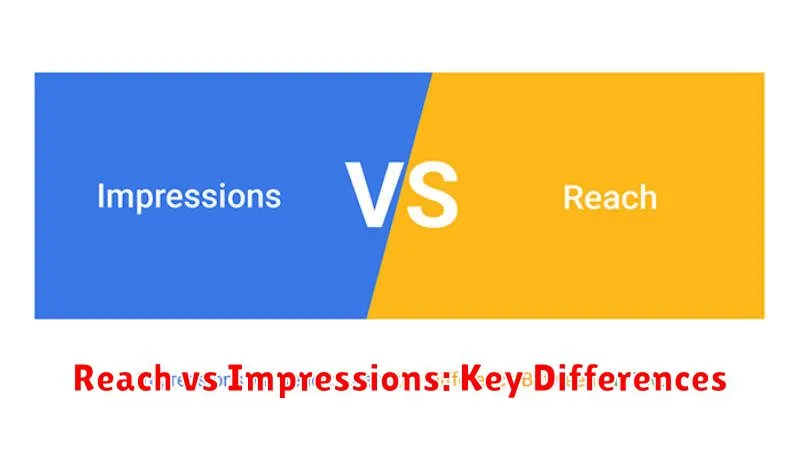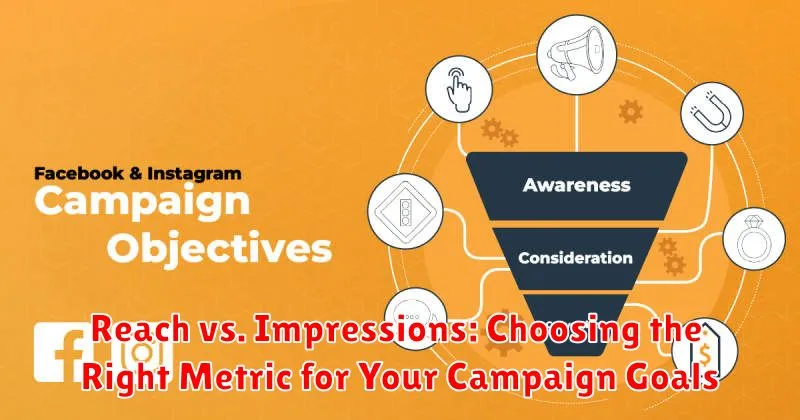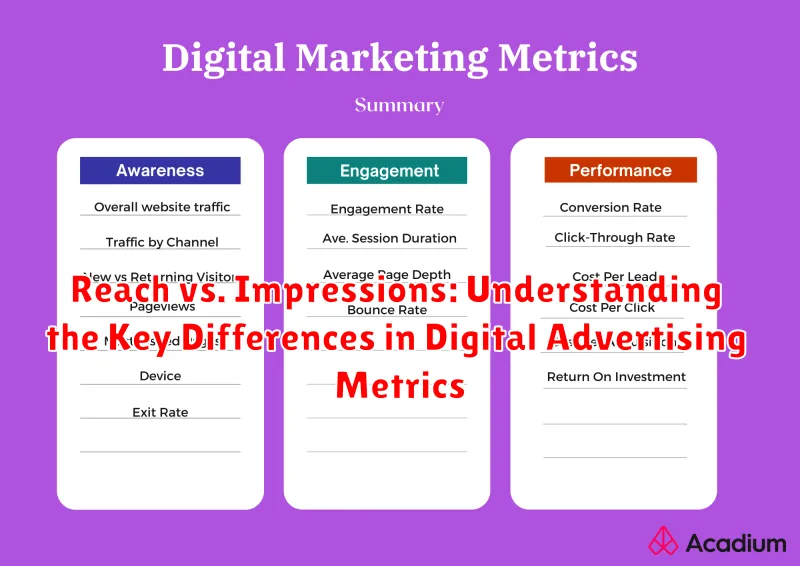In the realm of digital advertising, navigating the sea of metrics can feel overwhelming. Two terms that often surface, and are sometimes used interchangeably, are reach and impressions. However, understanding the distinct difference between these two key performance indicators (KPIs) is crucial for crafting effective advertising campaigns and accurately measuring their success. This article aims to demystify reach vs. impressions, providing a comprehensive overview of their unique roles in evaluating the impact of your digital marketing efforts.
While both reach and impressions offer valuable insights into your campaign’s performance, they measure fundamentally different aspects. Impressions quantify the total number of times your ad was displayed, regardless of whether it was seen by the same user multiple times. On the other hand, reach represents the total number of unique individuals who were exposed to your advertisement. By discerning these differences, marketers can gain a more granular understanding of their audience engagement and optimize their strategies for enhanced results in the competitive world of online advertising.
What is Reach in Digital Advertising?
In digital advertising, reach refers to the total number of unique individuals who have been exposed to a specific advertisement or campaign. It’s a measure of the audience size that has seen your content at least once. Reach focuses on unique viewers, meaning that if the same person sees an ad multiple times, they are only counted once in the reach metric.
Understanding reach is crucial for assessing the potential audience size you’re connecting with. It helps determine how widely your message is disseminated among your target demographic. A larger reach indicates that your ad is being seen by a greater number of distinct users.
Key characteristics of Reach:
- Counts unique individuals.
- Aims to expand audience awareness.
- Fundamental for brand awareness campaigns.
What are Impressions in Digital Advertising?
In digital advertising, impressions represent the total number of times your ad is displayed, regardless of whether it was clicked on or even viewed by a unique individual. Each time an ad is loaded on a webpage, app, or other digital platform, it counts as one impression.
Think of it as the opportunity for someone to see your ad. If the same person sees your ad multiple times on a single webpage or across different platforms, each viewing counts as a separate impression. Therefore, impressions are generally a larger number than reach, as they include repeated views by the same users.
Key characteristics of impressions:
- Measure the total ad views, not unique viewers.
- Reflect the potential visibility of your ad.
- Are a fundamental metric for assessing campaign delivery.
Understanding impressions is crucial for evaluating the overall visibility and potential impact of your digital advertising efforts.
Reach vs Impressions: Key Differences

The core difference between reach and impressions lies in what they measure. Reach represents the total number of *unique* individuals who have seen your advertisement. This metric focuses on audience size; one person seeing an ad multiple times still only counts as one in terms of reach.
Impressions, on the other hand, count the *total* number of times your advertisement has been displayed, regardless of whether it was shown to the same person repeatedly. If one person sees your ad five times, that counts as five impressions.
In essence, reach quantifies the *audience size*, while impressions quantify the *total exposure* of your ad. Understanding this distinction is crucial for analyzing campaign performance and aligning your metrics with your specific advertising goals.
Calculating Reach and Impressions
Understanding how to calculate reach and impressions is crucial for evaluating the effectiveness of digital advertising campaigns. While the exact calculations can vary based on the platform and tools used, the fundamental principles remain consistent.
Calculating Reach
Reach is generally calculated by determining the number of unique individuals exposed to your advertisement. This often involves tracking unique users through cookies or other identifiers. Platforms often provide reach metrics directly.
Calculating Impressions
Impressions are typically calculated by summing the total number of times your advertisement was displayed. This metric is usually readily available from advertising platforms. The calculation is straightforward: each time the ad is shown, it counts as one impression.
It’s important to note that some platforms may offer different methods or metrics for calculating reach and impressions. Consult the platform’s documentation for precise definitions and calculation methodologies.
Why are Reach and Impressions Important?
Reach and Impressions are vital metrics in digital advertising because they offer different perspectives on campaign performance. Reach indicates the unique audience exposed to your advertisement, helping you understand the scope of your campaign’s visibility. It answers the question: How many different people saw my ad?
Impressions, on the other hand, reflect the total number of times your ad was displayed, regardless of whether it was seen by the same person multiple times. This metric is crucial for understanding the overall frequency and saturation of your message. It answers the question: How many times was my ad displayed in total?
By monitoring both Reach and Impressions, marketers can gain a comprehensive understanding of their campaign’s impact, identify areas for optimization, and ultimately, make more informed decisions about budget allocation and targeting strategies. They help to measure brand awareness and the effectiveness of ad placement.
How to Optimize for Reach
Optimizing for reach involves maximizing the number of unique individuals exposed to your advertisement. Several strategies can be employed to enhance reach and ensure your message reaches the widest possible audience.
Target Broadly: Consider expanding your target audience demographics and interests. While precise targeting is valuable, overly narrow targeting can limit your reach potential.
Utilize Diverse Platforms: Distribute your advertising across multiple platforms (e.g., Facebook, Instagram, Google Ads, LinkedIn). Different platforms cater to different user bases, increasing your chances of reaching a wider audience.
Run Campaigns Over Longer Durations: Extending the duration of your campaign allows for increased exposure and the opportunity to reach individuals who may not be online every day.
Employ Frequency Capping: Implement frequency capping to prevent ad fatigue. Showing the same ad repeatedly to the same users can become intrusive and ineffective. Frequency capping helps ensure your ad is seen by more unique individuals.
How to Optimize for Impressions
Optimizing for impressions is crucial when your primary goal is to increase brand visibility and ensure your advertisement is seen as many times as possible. Here are some strategies to achieve this:
- Increase Bid Amounts: A higher bid can improve your ad’s chances of winning auctions, leading to more impressions.
- Widen Targeting Parameters: Broadening your target audience can increase the potential pool of users who may see your ad.
- Utilize Multiple Ad Platforms: Distributing your campaign across various platforms expands your reach and maximizes impression opportunities.
- Improve Ad Relevance: Ensure your ad creatives and landing pages are highly relevant to the keywords and targeting you are using. This can improve your Quality Score and ad rank.
- Focus on High-Traffic Websites and Placements: Prioritize advertising on websites and platforms known for high user traffic to increase visibility.
By employing these methods, you can effectively enhance the number of impressions your ad receives, boosting brand recognition and overall campaign awareness.
Reach vs. Impressions: Choosing the Right Metric for Your Campaign Goals

Selecting the appropriate metric between reach and impressions hinges on your campaign’s specific objectives. If your primary goal is to increase brand awareness and expose your message to a broad, unique audience, reach should be your focus. A high reach indicates that your advertisement is being seen by a large number of individuals.
Conversely, if your objective is to reinforce your message, increase familiarity, or drive conversions through repeated exposure, impressions are the more relevant metric. For instance, if you are running a campaign for a limited-time offer, maximizing impressions can help ensure that potential customers see the ad multiple times before the offer expires.
Consider a table comparing scenarios:
| Campaign Goal | Primary Metric |
|---|---|
| Brand Awareness | Reach |
| Message Reinforcement | Impressions |
| Driving Conversions (Repeated Exposure) | Impressions |
Ultimately, understanding the nuances of each metric and aligning them with your campaign goals is crucial for effective digital advertising.
The Relationship Between Reach, Frequency, and Impressions
Reach, frequency, and impressions are interconnected metrics in digital advertising. Understanding their relationship is crucial for effective campaign management.
Reach represents the total number of unique individuals exposed to your advertisement. Impressions count the total number of times your advertisement is displayed, including multiple views by the same user.
Frequency measures the average number of times an individual user sees your advertisement. It is calculated by dividing total impressions by reach: Frequency = Impressions / Reach.
A higher frequency means each reached user is seeing the ad multiple times. While this can increase brand recall, it can also lead to ad fatigue if the frequency is too high. Balancing reach and frequency is key to optimizing your campaign performance.

